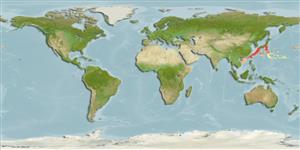Environment: milieu / climate zone / depth range / distribution range
Οικολογία
Θαλασσινό(ά) βαθύβιο(ς); εύρος βάθους 500 - 1985 m (Ref. 7460). Deep-water; 35°N - 34°S, 102°E - 153°W
Northwest Pacific: Japan and Taiwan; most probably in East China Sea and/or the Okinawa Trough, but rarely in the South China Sea. No reliable reports outside this area and need to be checked.
Μέγεθος / Βάρος / Age
Maturity: Lm ? range ? - ? cm
Max length : 14.0 cm SL αρσενικό/απροσδιόριστο; (Ref. 559)
Short description
Κλείδες προσδιορισμού | Μορφολογία | Μορφομετρία
A species belonging to the C. fimbriatus species group which is distinguished mainly from its congeners by having two large pale patches on its dorsal surface, one associated with the embedded third dorsal spine and another before the origin of the soft dorsal fin; mainly four neuromasts in the lower preopercular series (vs. mainly 3 in other congeners) (Ref. 94130).
Benthic (Ref. 58302). Edible (Ref. 637).
Life cycle and mating behavior
Γεννητική Ωρίμανση | Αναπαραγωγή | Γεννοβολία | Αβγά | Γονιμότητα | Προνύμφες
Masuda, H., K. Amaoka, C. Araga, T. Uyeno and T. Yoshino, 1984. The fishes of the Japanese Archipelago. Vol. 1. Tokai University Press, Tokyo, Japan. 437 p. (text). (Ref. 559)
IUCN Red List Status (Ref. 130435: Version 2024-1)
Threat to humans
Harmless
Human uses
αλιεία:
Εργαλεία
Special reports
Download XML
Διαδικτυακές πηγές
Estimates based on models
Preferred temperature (Ref.
123201): 3.5 - 6.5, mean 4.6 °C (based on 54 cells).
Phylogenetic diversity index (Ref.
82804): PD
50 = 0.5000 [Uniqueness, from 0.5 = low to 2.0 = high].
Bayesian length-weight: a=0.01122 (0.00514 - 0.02450), b=3.04 (2.87 - 3.21), in cm total length, based on all LWR estimates for this body shape (Ref.
93245).
Τροφικό Επίπεδο (Ref.
69278): 3.9 ±0.7 se; based on size and trophs of closest relatives
Fishing Vulnerability (Ref.
59153): Low vulnerability (10 of 100).
